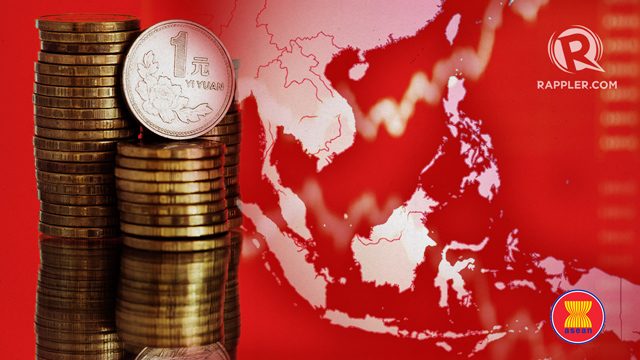SUMMARY
This is AI generated summarization, which may have errors. For context, always refer to the full article.
![[ANALYSIS] ASEAN likes, but also fears, China’s economic weight](https://www.rappler.com/tachyon/r3-assets/8EE06596BC8548BABCFEED15637534A4/img/725E7A9E5F00492AAB39D6B71231DC43/johanna-son.jpg)
Despite China’s growing economic footprint in Southeast Asia, the country does not quite have that mammoth clout in the region – yet. But the day it acquires that too much economic weight for comfort – with handy geopolitical weapon to boot – may not be that far away in the horizon.
How it turns out depends on factors that bear watching – the pace and depth of ASEAN countries’ regional integration efforts and diversification of its economic relationships, China’s calibration of the “quality” of its economic engagement in the region and its trust deficit, and ASEAN societies’ response to China’s style of economic cooperation.
Recent analyses make the case for why ASEAN’s 10 member countries need to work on deepening trade and investment ties among themselves – for their own economic resilience and to maintain precious elbow room in international relations given the likelihood that China will use its economic weight in the pursuit of strategic interests in issues such as the South China Sea disputes.

At present, China is more of a trade power than it is a major player in foreign direct investments (FDI) in the ASEAN region, according to a paper published this month by the Singapore-based ISEAS Yusof Ishak Institute.
“Although China has leverage in terms of trade, its investments are yet to catch up with those from other developed countries. China can therefore not really as yet be called a dominant economic power in Southeast Asia,” said the paper by Sanjita Basu Das, lead researcher for economic affairs at the ASEAN Studies Center, ISEAS Yusof Ishak Institute. “However, as China increases its outbound investments and completes more infrastructure projects, its geopolitical influence in the region will definitely increase.”
“One cannot conclude outright that China is a dominant economic power in Southeast Asia for FDI, which one can do when it comes to trade,” Das explained. “Apart from the less developed ASEAN members – Cambodia, Laos, and Myanmar – Beijing is not really capable of holding ASEAN countries hostage economically to advance its strategic demands.”
Danger: Overdependence
In recent years, ASEAN countries have become much more trade dependent on China. All member economies except Singapore have trade deficits with the world’s largest trading nation, meaning they rely on China for much of their imports, ASEAN data show.
The volume of ASEAN-China trade stood at $345 billion in 2015, the second largest after the $543-billion volume of intra-ASEAN trade. After China came ASEAN’s trade with Japan, the European Union and the United States, with trade volumes of more than $200 billion. China has been ASEAN’s largest trading partner since 2009.
From 2005 to 2015, China’s trade with ASEAN grew by the largest margin – 13.2% – among its trade partners. South Korea-ASEAN trade grew by 10.9% over the same period, but ASEAN’s trade with the EU, Japan, and the US grew only by 5.4%, 5%, and 3.6%, respectively.
In other words, “the weight of advanced economies in ASEAN’s total trade has been declining, while that of China’s is on the rise,” wrote Das. “As multinational firms undertook single production processes across multiple countries over the last few decades, China and ASEAN economies have become intertwined in a web of regional production networks, thus increasing their mutual dependence.”
In terms of FDI, China still lags behind intra-ASEAN investments, which made up 18% of total FDI flows in the region, and those of the European Union, Japan, and the United States. However, the growth rate of FDI inflows into ASEAN in 2005-2015 reached 33.4% from China and 30.3% from South Korea.
Likewise, given China’s strategic push in Cambodia, Lao People’s Democratic Republic, and Myanmar and the sharp rise in its own outward investments, it is a much bigger investor there than it is in other ASEAN countries. China is the largest source of foreign investments in Cambodia and Laos. As of end-2016, it accounted for close to 35% of Cambodia’s FDI. In Lao PDR, China’s accumulated investments exceeded $6 billion in 2016.
Overall, the more diversified mix of FDI in ASEAN means that there is no one single dominant source of investments for the region, one that can only be good for ASEAN’s economic health. The US is a leading investor in the Philippines and Malaysia, but the EU leads in Singapore. Japan is a major investor in Thailand and Indonesia, while South Korea is the one in Vietnam and Malaysia, as Das’ paper shows.
China’s growing economic footprint brings with it a new appreciation for the progress ASEAN has made – though it could be deeper – in relying more on its own members through regional economic integration over the past 5 decades.
ASEAN countries are a key source of investments among themselves, particularly in Indonesia, Singapore, Malaysia, Myanmar, and Vietnam. But China’s growing FDI in the region may actually be bigger, if one considers the fact that Hong Kong is a gateway for investment in the region.
As China’s FDI outflows pick up – partly due to its search for overseas destinations to invest overcapacity in steel and cement – these investment figures look certain to go up in ASEAN. “Moreover, given the huge demand for infrastructure financing among the Southeast Asian countries and China’s indifferent attitude towards political systems and human rights, the quantum of investment flows could grow considerably,” Das said.
Chinese infrastructure engagement is expected to grow, given its One Belt, One Road (OBOR) Initiative and funding through the Asian Infrastructure Investment Bank and cooperation funds with ASEAN. These come with Chinese workers, equipment, and construction materials that have not met with wholesale optimism in countries like Laos, Thailand, Indonesia, or Malaysia because they do not provide local jobs or skills transfer, among others.
China needs to be sensitive as well to the “soft” side of the impact of its economic presence in investments, trade or aid – and where it may well have a learning curve as a regional power compared to, say, the longer involvements of Japan or the United States in the region.
What, then, can ASEAN do? “To mitigate the risks, the ASEAN countries must strengthen their own economic integration,” Das wrote. While ASEAN member countries are “already prominent trade and investment partners among themselves,” they need to put in place cross-border policies that keep foreign investors coming.
“In addition, the ASEAN countries must diversify their trading basket across major economies,” she pointed out. Among others, ASEAN and EU may be restarting talks over an ASEAN-EU free trade agreement, previously stalled by human rights issues over Myanmar.
One major way would be for ASEAN to speed up completion of the Regional Comprehensive Economic Partnership (RCEP), one of ASEAN’s deliverables during its 50th anniversary this year. But however much analysts say it is virtually the only regional economic game in town – with the collapse of the Trans-Pacific Partnership and with the Asia-Pacific Economic Cooperation (APEC) far from being a trade negotiating forum – RCEP is nowhere near completion.
After 19 rounds of negotiations as of July this year, ASEAN-led RCEP discussions have become caught in differences over tariff reduction offers, the degree of liberalization in services and the movement of professionals, reflecting the challenge of building what is to be the largest trade deal encompassing nearly half of the world’s population, 30% of global income, and 30% of global trade.
When it does bring together ASEAN and its 6 existing trade agreement partners – Australia, China, India, Japan, New Zealand, and South Korea – RCEP would be “the most important example of ASEAN Centrality and its benefits for ASEAN states,” pointed out Malcolm Cook and Das in an October paper on “RCEP’s Strategic Opportunity.”
If RCEP gets completed in 2018, the ratification process would likely take one year so implementation would start earliest in 2020, the paper added.
ASEAN countries are well aware that putting too many eggs in China’s basket opens them to bullying if Beijing chooses to push economic diplomacy and use its economic power in the geopolitical sphere.
Das’ paper has a reminder of how South Korea got a taste of “economic retribution” when earlier in 2017, China punished it for its installation of the US missile defense system THAAD. China’s increased scrutiny of South Korea’s Lotte Mart led to the closure of most of its stores in China, whose government also advised Chinese tour groups to stay away.
Economics is politics, too
While ASEAN states are drawn to easier access to China’s funds, “the OBOR Initiative has fueled concern among many Southeast Asia countries about the security risks of economic overdependence on China,” said a November paper on “Infrastructure Connectivity and Regional Economic Integration in East Asia: Progress and Challenges,” published by the Lee Kwan Yew School of Public Policy in Singapore. “Hence, Southeast Asian countries are cautious [about] becoming economically over-dependent on China as they fear being forced to adopt a pro-China foreign policy stance.”
Given China’s assertiveness in the South China Sea, Das wrote: “If the maritime disputes remain unresolved, Beijing may be tempted to use its economic leverage to advance its strategic objectives in the SCS and beyond. It may also try to own infrastructure assets in ASEAN to service its national interests.”
This may be similar to China’s investment in Sri Lanka’s strategic Hambatota port, which has come under scrutiny as a brand of China’s economic presence. China is involved in huge infrastructure projects in ASEAN, such as the construction of the Vientiane-Kunming railway.
“China’s perceived assertiveness in foreign policy, particularly in relation to territorial disputes in the South and East China Sea, is unfortunately helping to create a negative state image for China abroad,” said the LKY School of Public Policy paper on infrastructure in East Asia.
“This is not supportive of China’s ambition to be perceived as a responsible and friendly power in the region and beyond.” – Rappler.com
Johanna Son, a Bangkok-based editor/founder of the Reporting ASEAN media programme, has followed regional and ASEAN issues for more than two decades.
Add a comment
How does this make you feel?





There are no comments yet. Add your comment to start the conversation.